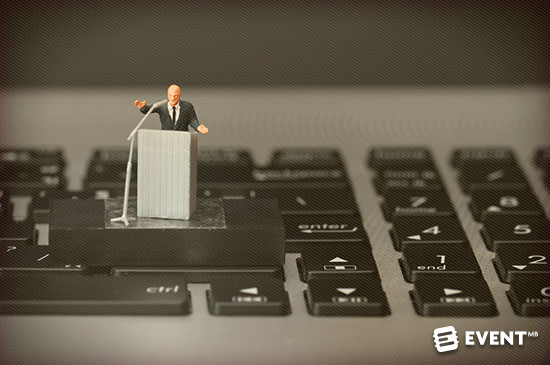Event planners can learn a lot from the next level social media strategies implemented during the RNC and DNC Conventions. Integrated strategies, new platforms, and data are paving the way for the evolution of events. Here are the top seven social media lessons for your events.
Disclaimer: You will not find any discussion of politics or opinions on the candidates in this article. What you will find is an analysis of some of the most impactful social media tactics being used today to facilitate the goals of live events. As someone who lives in a city where a convention was held, I can tell you that these conventions have a huge impact on our industry from design, to technology, and above all else: messaging.
While 2008 was often called “The Social Media Election”, we now know that to be a premature statement. The difference between the sophistication and adoption of social media platforms between 2008 and 2016 is staggering. Those that were 13 years old during the 2008 election can now vote themselves and have grown up in a world where social media was always there. This isn’t some voters second screen, it’s their first.
These advanced strategies witnessed at the conventions can teach event planners a lot about how messaging and how engagement is more than just tweeting quotes from presenters.
What Makes 2016 Different
In 2008 and 2012, we did not have Snapchat or live streaming social media options from our phones. Until this year, the ability for anyone to cover a live event and broadcast it to their followers was clunky and couldn’t really compete with major media. In 2016, campaign strategists were much more focused on what has been dubbed “small screen coverage” due to its immediacy, data collection, and intimacy. 2014 was the first year that Americans, in aggregate, had spent more time in front of their smartphone screens than they did in front of their television screens.
Representatives from Google, Facebook, and Twitter had huge footprints during the campaigns and bought out nearby venues in order to provide analysis for the scores of different groups assembled. These groups with billions of dollars, unlimited influence, and very serious work in front of them put a historically high value on social media during their conventions. My question to you: are you giving your event’s social strategy the proportionate attention?
The First Snapchat President
The younger demographics are always the hardest to court for any strategy. They are generally less loyal to established outlets, adopt and discard technology faster, and can smell disingenuousness a mile away. That’s why, for right now, they are on Snapchat in record numbers. More than just the parties themselves invested in Snapchat heavily for the convention. During the RNC Convention, Cleveland’s newspaper’s website “Cleveland.com”, had one of the most innovative and emulatable social media strategies I’ve seen in years for the convention.
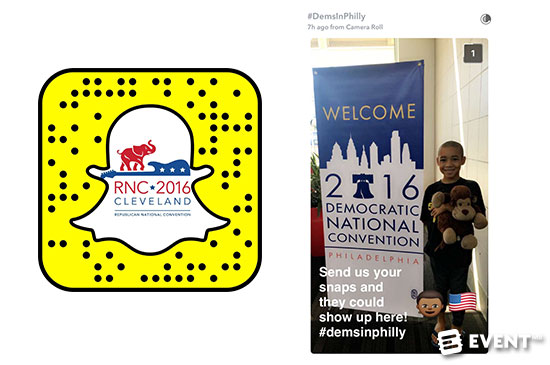
If Snapchat becomes a big part of your strategy, make sure to have your Snapcode visible in as many places as possible in order to gain follower traction.
Calls to action for attendees to send you their snaps is an important way to engage and measure success.
Voices of an Event
Cleveland.com chose four of the biggest stars of Snapchat and gave them each a day of the convention to take over their account. The personalities of these influencers were wildly different and provided a much needed variety in context to what was covered. Instead of utilizing a single gatekeeper for content that was created from the event, diversity of points of view were celebrated giving viewers something different each day.
For trade shows and conferences, this type of coverage opens up lots of possibilities for this platform. The personality holding the phone is pretty much everything when it comes to what Snapchat users look for when choosing to follow and engage with an account. If you are a community manager for an event and you brand is not centered around the personality of any one person, Snapchat takeovers are great way to appeal to those looking for more intimacy and transparency. What made this strategy more compelling was the use of influencers. If you can tap into the fan-bases of influencers specific to your events goals and target markets, you’ll likely bring them along for the ride as well and potentially retain them for the long term.
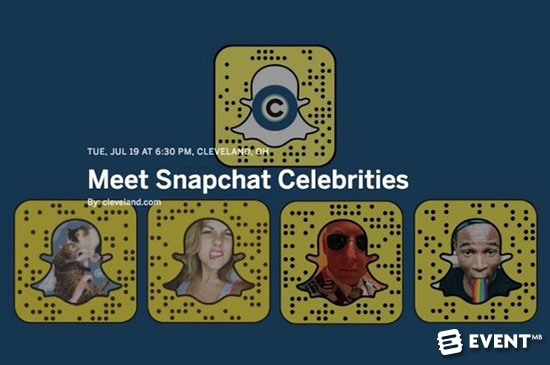
If you choose to have multiple voices and your event features speakers, consider giving them a panel near the end of the event so that people can meet the people they’ve been following.
On-Demand Geofilters
Snapchat opened up the ability for anyone to submit designs to Snapchat to approve that allow others to add the designs to their snaps when in a given space at a given time. Snapchat covered both the RNC and DNC conventions and gave those in the area the opportunity to add the geo-filters they created to their photos if they were in the Cleveland or Philadelphia area at that time. What these provided for attendees was context to the experiences they were having. Snapchat is the only one that currently has access to analytics associated with geofilter use. This means that the designs they themselves create have the chance to be the most optimal because they benefit from engagement data. They use basically the same designs for both the RNC and DNC in a perceived effort of impartiality. Let’s see what we can learn from these designs that will impact how you design your event’s on-demand geofilters.
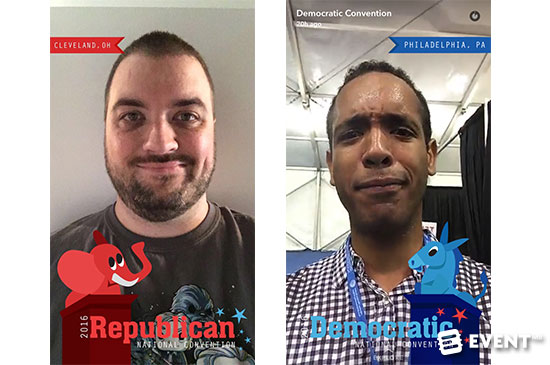
These are pretty standard designs for Snapchat filters. The design allows for easy framing and does not obscure too much of the photo or video in the middle. The biggest takeaway here is whimsical depiction of the elephant and donkey. The Snapchat experience features lots of cartoon art in the form of stickers, lenses, and even the recent inclusion of Bitmoji. Take this lighter tone into consideration when designing for your event.
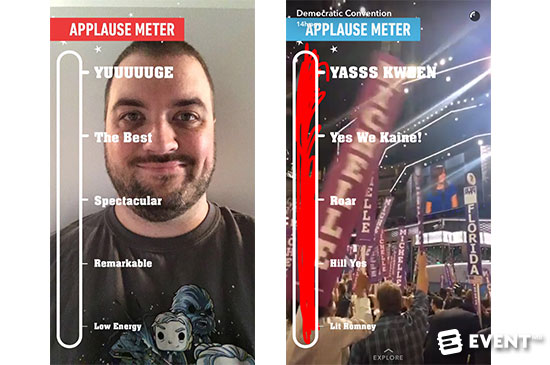
This is next level geofilter designing! The applause meter design is something you can absolutely incorporate into your events because this provides in the moment context of an experience and participatory engagement. Users who choose this geofilter can color in the thermometer to give their opinion of what is happening in that moment. This is what on-demand geofilters have over hashtags. What makes this all the more fun (and then more likely to be used) are the terms used to measure the applause. Each convention had different terms that would resonate with their specific audience. Knowing your audience is everything and using terminology that means something to them is a way to show that you understand them.
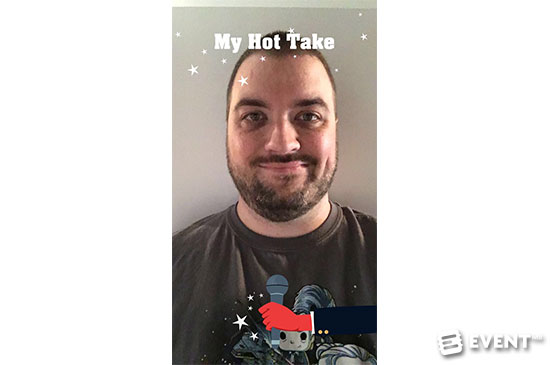
This simple design pushes people to give their feedback. This type of design can be implemented as a way to get testimonials. By asking (or creating a contest and incentivizing) Snapchat using attendees to send their testimonial related videos using this filter, you could easily create a stitched together marketing piece of third party reviews using a social media that gives you instant credibility with Snapchat fans.
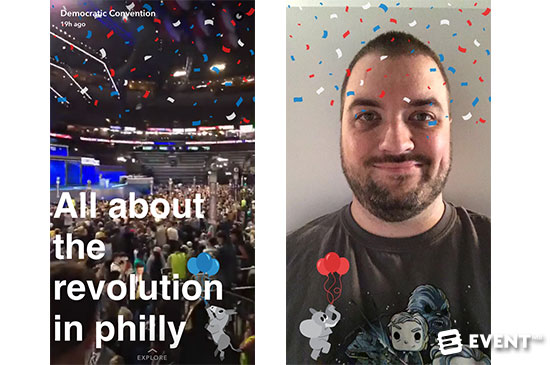
Sometimes smaller is better. This little cartoon image allows for photos and videos to be the least obstructed. Someday when regular advertisers get more access to analytics, we’ll be able to see the difference in adoption rates based on the footprint a design takes up. Until then, using Snapchat’s own designs as a basis is probably wise.
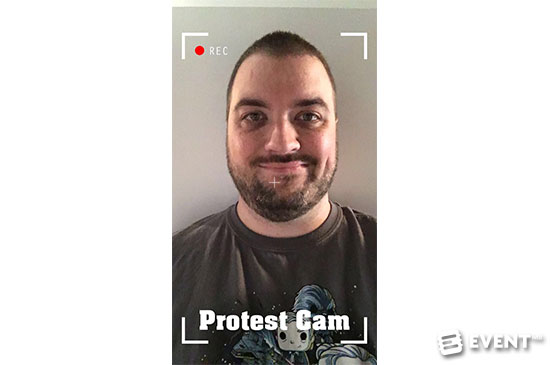
This one might seem specific to the political conventions but the lessons you can learn from this are adaptable for your event. If you know of a specific activity that will take place during your event, a custom geofilter for the specific time it takes place would be widely adopted. If you have multiple speakers, consider a geo tag for their time on stage. Multi-day events often have many different micro-events taking place within the schedule, by including a different design for them it breaks up the monotony of using the same filter the whole time and is a chance to potentially show off a sponsor.
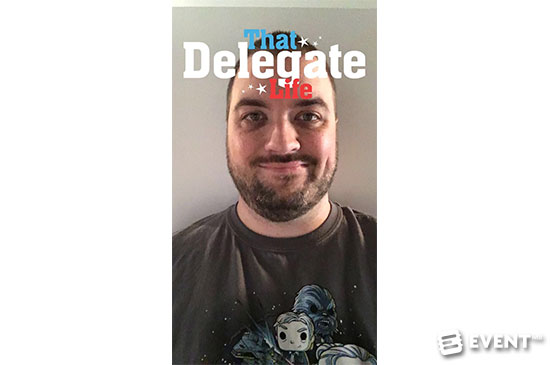
Delegates were the VIPS of the convention and creating a geofilter just for them was a smart way to show that off. If your event has different credential levels: VIP, Sponsors, Speakers, etc., consider an alternative design for them. They are likely to be influencers and giving them something special should increase their engagement.
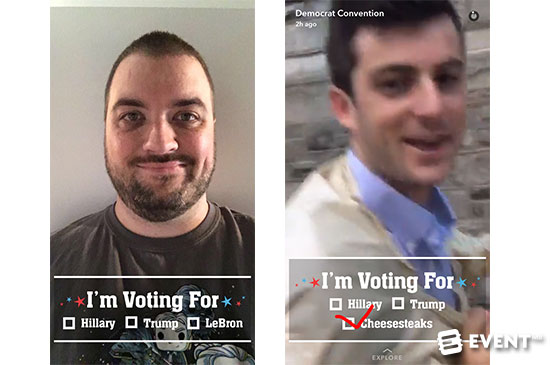
This one has it all. Element of humor, knows the audience, lots of negative space, event specific context and motivation for engagement. While this looks simple enough in terms of a design, it accomplishes everything you want from an event specific on-demand geofilter. Asking your attendees for input in an intuitive way that integrates with engagement they are already using is always a sound strategy.
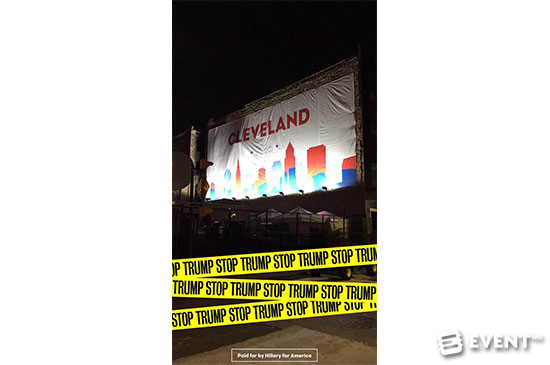
This strategy is bold but I can personally attest to using similar strategies to success. This on-demand geofilter was not an official filter of the convention but was instead created by Democrats with the goal of disrupting the RNC messaging. For event professionals, this type of guerilla marketing is a potential option. You could have misgivings on the idea of creating a design for the time and location of a rival event but be aware that the option usually exists for them to do the same to you. I caution jumping into this type of strategy without a great understanding of who you might alienate along the way. If you are exhibiting at a trade show, creating a geofilter for the entire footprint of the show with your booth number is a smart guerrilla marketing move that’s a lot cheaper than a sponsorship.
Social Data For Decision Making
Your attendees are providing you the exact information you need to run your event better…but are you capturing that data? The RNC and DNC worked intimately with Google, Facebook, and Twitter to gather live data that they used to make changes to speeches and appearances during the convention. While most of us don’t have access to these big data resources directly (or the level of content needed to make decisions from real-time search data), there are still ways social data can impact your events.
There are many online resources for hashtag data that can show you the how many posts happened with your event’s hashtag in 30 minute intervals as well as the words used most frequently. This type of data can tell you which element of your event or which speaker resonated the most with attendees and potentially why. This information is incredibly useful when planning reoccurring events because it’s a metric you can you to determine curriculum and speaker selection. That type of social data in addition to post event survey results give you exactly what you need to plan your next event.
Many of the web-based social media wall software used at events can provide you with analytics such as most prolific tweeter, most influential contributor, and the attendee with the largest audience. By using that information, you can court these influencers in a variety of ways. You could provide higher ticket swag items only to them knowing that it will have a larger impact. One effective tactic would be to reach out to them after the event and offer them a position on an advisory board or as brand champions or ambassadors for the next event. Influencer marketing continues to be a dominating strategy on social media and knowing who the best influencers are is key.
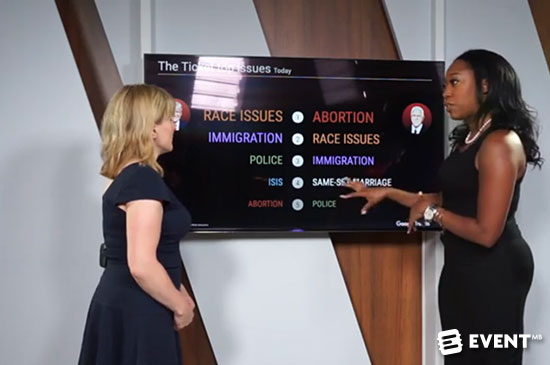
Representatives from Google created custom dashboards pulling real-time search data in order to gauge reactions.
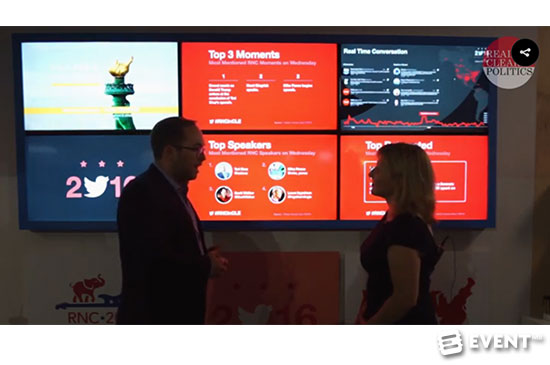
Some of the data being collected in real-time was displayed publically during the conferences.
Live Streaming Integration
Besides Snapchat, the biggest evolution in social media that impacted the RNC and DNC for the first time was live streaming apps. While being able to live stream an event over the Internet has been commercially available for over a decade, the ability for anyone do it for free from their phones on platforms already integrated into people’s lives is a new frontier.
The main streaming services used by both the conferences and by attendees were Facebook Live and Periscope. While both do very similar work, their audiences are based on their parent companies (Facebook and Twitter). Attendees seemed to be using Periscope as a way to share their experiences with anyone on Twitter who found them (due to its more open discoverability) while official conference partners and major media tended to focus on Facebook Live (likely for its broader and older demographics).
When determining your live streaming strategy for your event, make sure you are offering something to those watching from their homes and offices that provides value to them, your brand, and your sponsors. Make sure you have a shot list and storyboard of what you will be covering and don’t make it up as you go along. Know that you can archive this video and use it in your marketing throughout the year for future events and campaigns. Create FOMO for those who did not attend in order to boost your attendance for future events.
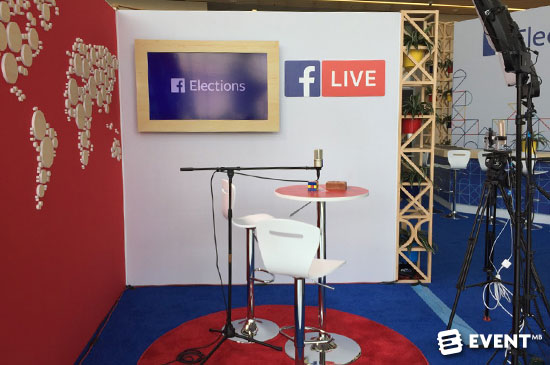
Designing a space for your broadcasts gives a much more professional look and it gives another opportunity for sponsor logo placement.
Digital Green Room
Dubbed the “Digital Loft” at the RNC Convention, this proved to me how serious these conventions took social media. In what was essentially their green room, presenters had their photos taken for Instagram and a question asked of them on Snapchat before giving their presentation and immediately following their presentation, they sat down for a Q&A session on Facebook Live. The flow of their event was absolutely integrated with social media and communication and it was a well-oiled media machine!
Many of us operate multi-channel social media strategies for our events but when it comes to executing them on-site, end up just running around trying to get coverage sporadically. Know that when you treat social media like an afterthought, your followers can tell. Making your social media strategy a priority and part of the actual flow of the show produces superior results.
Innovative Conference App Features
While conference apps are a true staple, providing add-ons that are outside of most templates are seen less and less frequently. Both the DNC and RNC apps had a few memorable features. Integration of 360 degree videos and photos was something I really appreciated in both the DNC and RNC’s new app. Especially inside the stadium and outdoors in large crowds, it feed my voyeuristic needs and used a web outlet that didn’t exist last election. Wrap-up videos from previous portions of the conference are a great way to share parts an attendee may have missed.
Another app design lesson I learned is the inclusion of information on the host city. As someone who travels to conferences regularly, finding my way around a city with the little time I have is beneficial and appreciated.
Social Media for Customer Service
Especially for multi-day events, social media provides an opportunity for two-way conversation beyond your messaging goals and marketing. People want instant answers to their questions and will use the platforms they are most comfortable with. Make sure that someone is always available as a concierge. This person should be familiar with not only the schedule and event venue layout but also surrounding restaurants and hotspots. During the RNC, they even created a specific hashtag just for questions about the city and where to go – #AskCLE. This is a great job for a local or even through a partnership with your Conventions and Visitors Bureau.
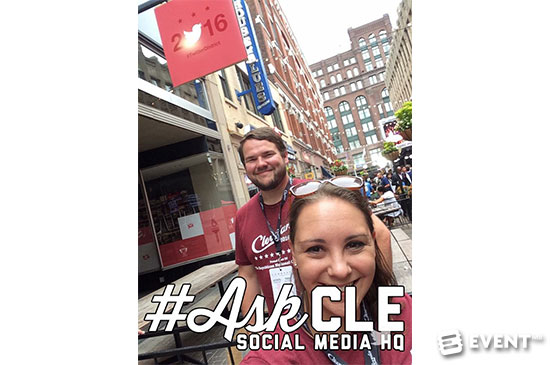
Members of the Destination Cleveland social media team during the RNC.
In Conclusion
So far this year on Facebook there have been 89 million people having over 2.9 billion interactions on the topic of the presidential election. It’s an unprecedented level of social media engagement showing just how far these communications platforms have come in the past four years. If your event goals revolve around messaging of any kind, you need to understand what these major political parties have grasped – social media is the dominant way we communicate now.
Treating the role of social media at your events as an afterthought or a bolt on to your overall strategy is no longer going to cut it. It’s time to have a real understanding of all the tactics available through social media and to integrate them directly into your event. Learn from these social media lessons, think like a campaign strategist and win over the hearts and minds of your attendees and future attendees.
